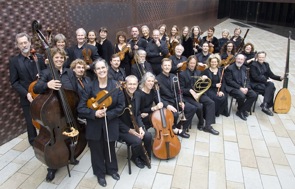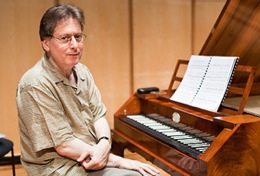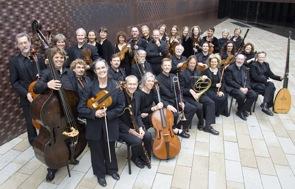
If ever there were a composer whose music justified the use of old instruments, it is Wolfgang Amadeus Mozart. Modern pianists and orchestras frequently approach Wolfie’s music as if they’ve got kid gloves on. The extremes of dynamics rarely reach above a mezzoforte, since they say that modern instruments are so much louder than period instruments. And displays of virtuosity seem almost always subordinate to displays of grace and elegance. Even something like the Piano Concerto K. 466, so beloved by the 19th century as indicative of the storm-and-stress aesthetics that characterized much art during their era, can suffer from such mollification.
This was most certainly not the case when Philharmonia Baroque Orchestra teamed with fortepianist Robert Levin Saturday to present an all-Mozart program at Berkeley’s First Congregational Church. The concert opened with music for the play Thamos, King of Egypt, the composer’s sole attempt at incidental music. The piece opened as a sort of contrived instrumental suite, drawn from three entr’actes that originally occurred, interspersed, throughout the play. It was at the opening of the third of these pieces that I suddenly realized that this was not going to be my grandmother’s idea of Mozart. As the lyrical second entr’acte drifted away, the last selection erupted with a torrent of sound. There was nothing particularly interesting, formally, about this Mozart finale; it made a logical conclusion to this little quasi-symphony in terms of closure, but didn’t really expand my ideas of what Mozart’s music is all about. But what was eye-opening was the amount of sound that PBO generated. They pushed their instruments to what seemed their outer limits. The kettle drums boomed, the string players sawed away with a frenetic look in their eyes, and Music Director Nicolas McGegan hopped up and down on his podium in an effort to coax ever more sound out of them.
This was a portent of things that were to come from McGegan throughout the evening. His conducting gestures are often a bit nonconformist, but they always clearly reflect the musical material and McGegan’s demands on his orchestra. Saturday night’s choreography was full of upward and downward pointing fingers, elbows jabbing out into space in jauntily comic fashion, and, of course, McGegan’s characteristic hopping. And all of it inspired the players to paint a portrait of Mozart that is more in line with the letters and reminiscences about the man and his performance style than the sanitized mainstream Mozart we’ve come to expect. The results were never inelegant, but neither were they ever overrefined. In short, they were scintillating.

McGegan didn’t have to look far for inspiration from another great Mozart interpreter, since he was sharing the stage with Robert Levin, one of the foremost fortepianists in the world and an expert at stylistically appropriate improvisation. At the opening of the concerto K. 466, I was a bit worried. Levin has made a habit of playing continuo along with the orchestra during the bits where there is no solo part, a practice that Mozart probably also followed. What worried me was that I couldn’t hear the piano at all during the first movement’s opening exposition. I could see Levin’s fingers moving, and marveled at the expressiveness and obvious élan that crept over his face as the stormy opening faded away to the lyrical second theme. But I couldn’t hear a thing.
No matter, once the solo lines began. It was surely a combination of Mozart’s careful orchestration, tessitura planning, and the conductor’s judicious lowering of the dynamics that made the fortepiano ring out clearly. The instrument, which hails from McGegan’s living room, was made by Tom and Barbara Wolf, a husband-and-wife building-team based in the Washington, D.C., area. It stayed marvelously in tune despite the heat in the sanctuary, and, though Levin appeared to push it to its limits at times, the piano also delivered every expression of rhythmic fury or singing lyricism that he demanded of it.
Levin improvised his way through a great deal of the passagework in this performance, arpeggiating chords, adding eyebrow-raising rocket gestures, and occasionally filling in harmonies. None of it was ever distracting — rather, his additions were always ornamental, always folded into the musical fabric in a manner that reminded us that we were hearing Mozart’s music in fancy garb, rather than some misguided recomposition. If I had been in a really bad mood, I suppose that I could have had some qualms with Levin’s improvised cadenza in the first movement of K. 466, which sounded a bit Beethovenian in its tortured chromaticism and strings of rapid sequential arpeggiation. (There was even one instance of the infamous “fate motive” from the Fifth Symphony, right down at the bottom of the piano. Surely it was coincidental, but it definitely was there, audibly delivered with both hands in homophonic synchrony.) But this concerto is Mozart at his most “Beethovenian,” after all. The work has bits of thematic unity between the movements, a stormy passion that pervades the whole, and an unpredictability of form that, as I often forget, is one of Mozart’s greatest virtues in his concertos. If Beethoven did receive Mozart’s spirit through Haydn’s hands, this may well have been one of the pieces that acted as a channel between the men.
Audience Participation
The second half of the concert opened with Levin improvising on themes that the audience provided during intermission. He sifted through a stack of little manuscript paper, choosing bits that were composed by Mozart. Levin gave us the chance to vote on whether we wanted to hear his own variations on Ah! Vous dirai-je, Maman (the same tune as Twinkle, Twinkle Little Star). Thankfully, there was a cry of “NO” from the audience, so Levin settled for a snippet from The Magic Flute, alongside two other brief extracts, and crafted an eight-minute piece on them.
I’ve heard Levin do this party trick before, and never fail to be moved by it. Actually, it’s unfair to call it a “party trick” at all, since Levin, unlike some other performers skilled in this type of improvisation, really does manage to make satisfying, balanced musical structures during his flights of fancy. Large sections recapitulate, there is almost never any sense of harmonic confusion or unfortunate anachronism, and Levin himself always appears fully engaged with the process, often smiling broadly at some phrasal relationship that must have come out of his fingers before he knew exactly what was happening. This is an audience favorite at every concert where Levin does this, and for good reason.
Levin also presented two completions of works from Mozart’s sister’s music-book, pieces that have recently been determined to be by Wolfgang himself. The works were, as Levin warned us, not of sufficient caliber that they would transform our ideas about Mozart. They were, after all, written when the kid was just 7 or 8 years old. But the little prelude that opened the set was a satisfying binary piece in the style of the previous generation, full of ferociously difficult passagework. The succeeding concerto was a Baroque-style structure, with statically alternating ritornellos and solo passages, following a predictable key scheme. Yet the communication between conductor, soloist, and orchestra was fabulous, and I was quite glad to hear the piece, slight though it may have been.
Space doesn’t allow me to wax enthusiastic about PBO’s rendition of the “Jupiter” Symphony. Suffice it to say that the performance reminded me why this piece made it through the 19th century with an almost wholly unblemished reputation. The 41st Symphony is one of those pieces that nobody plays anymore because they assume that everybody plays it all the time. This was, shockingly enough, only the second time that I’ve ever heard it live in concert. And after hearing a performance like this, in which the clarity of the extraordinary counterpoint in the finale took my breath away, I can hardly wait for the next time I have the opportunity. When I do, my expectations will be high: PBO’s will be a tough act to follow.

